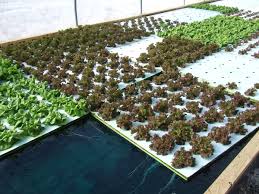Deep Water Cultivation Systems

A mix of crops and ages in a commercial scale deep water cultivation system. If you look closely, you can see some of the plants' root masses dangling in the reservoir. Image courtesy of astfilters.com.
You are on Page 6 of our six page series on deep water cultivation systems. Click on any of the below pages to jump to that page.
Page 1 Page 2 Page 3 Page 4 Page 5 Page 6
Helpful Hints
Thankfully, deep water cultivation is so straightforward that it’s tough to get into trouble with this system. Nevertheless, here are a few pointers to help new growers with this approach:
- If you want to build your own system, try to work from existing plans, and use the recommended dimensions and materials. Even better, go tour a few DWC operations so that you can see first-hand how the system works. The best option is to see different DWC operations of different sizes. This way, you can compare how hobbyist and small-scale commercial DWC systems differ from larger operations.
- Whatever size of operation you decide on, plan on using more air stones than you think you’ll need. Air stones are cheap to buy and absolutely critical to the correct performance of the system. Additionally, you may not immediately know if one or more air stones have become blocked up such that they aren’t putting out bubbles anymore. Check your air stones at least once a day, and have replacements immediately available.
- Given that the nutrient solution doesn’t circulate, and given that the roots dangle right into the solution, it can be tempting to just ignore the solution itself. However, the nutrient solution’s concentration of nutrients is always changing. Test it at least once a day and have an efficient procedure in place to renew the nutrients as often as needed.
- In concert with the above, keep in mind that growing crops will use up different nutrients at different rates, depending on where the plants are in their life cycles. If multiple ages of the same crop (or the crops are mixed) are kept in the system over long periods of time (ie, there’s always something being planted and harvestest), then the changes will average out over time. However, if a uniform planting is moved into the system all at once, then allowed to grow and then harvested all at once, nutrient consumption will change dramatically over time. Careful and frequent monitoring will tell you when nutrients need to be replentished.
- If you want to experiment with some marginal crops in a DWC system, such as tall and/or heavy crops, or crops which need higher than average oxygenation, start small. Don’t fill up a huge reservoir with rafts of a marginal crop; the results might be a large-scale failure. Much better to have a small system which can be easily adjusted over time. Then when you’ve worked out the kinks, you can go bigger.
- In addition to having replacement air stones, always have a spare air pump too, and some spare air hose. Plentiful air stones don’t do you any good if your one pump goes out. Always better to have replacements of any needed equipment.
More Information
Before we get into various online resources, be advised that some folks and some reference materials refer to ALL hydroponic methods as “water culture”. So when you do a search for more information, be aware that some of the results you’ll get will pertain to other hydroponic methods, or hydroponics in general.
With that being said, here are a few resources for DWC in particular:
- This article (https://www.maximumyield.com/what-is-a-deep-water-culture-system/2/1415) from Maximum Yield magazine offers a nice overview of DWC, along with some details which we haven’t covered here. Additionally, at the bottom they provide additional resources, including sets of plans.
- The Food and Agriculture Organization of the United Nations (typically known as the FAO) has published a great deal of information on various agricultural systems, including hydroponics and the closely related aquaponics. They have a nice article on using deep water culture in aquaponics. That article is available here: http://teca.fao.org/read/8397. While the article focuses on aquaponics rather than hydroponics, the only difference between the two is that aquaponics uses fish waste as the nutrient source, rather than dissolved chemicals used in hydroponics. Almost everything else is the same between the two approaches. The one additional difference is that sometimes fish will nibble on the roots of plants being grown in aquaponic deep water culture. Those differences aside, the article provides a tremendous amount of information, aimed specifically at small-scale growers.
- As we’ve already seen, lettuces are one of the main crops being used in deep water culture. As such, there is a lot of research being done to optimize lettuce production in DWC. One such research project is available online from Auburn University, courtesy of a grad student doing research there. Her paper, “Improving Lettuce Production In Deep Water Culture in the Southeastern United States”, should definitely spark interest in anyone wanting to grow lettuce or salad greens. The abstract is available here https://etd.auburn.edu/handle/10415/5944 . The entire research paper is available for free download from that same page.
The above sources give a variety of different in-depth looks into different aspects of DWC production. As we become aware of more sources, we’ll post them here.
Back
You are on Page 6 of our six page series on deep water cultivation systems. Click on any of the below pages to jump to that page.
Page 1 Page 2 Page 3 Page 4 Page 5 Page 6